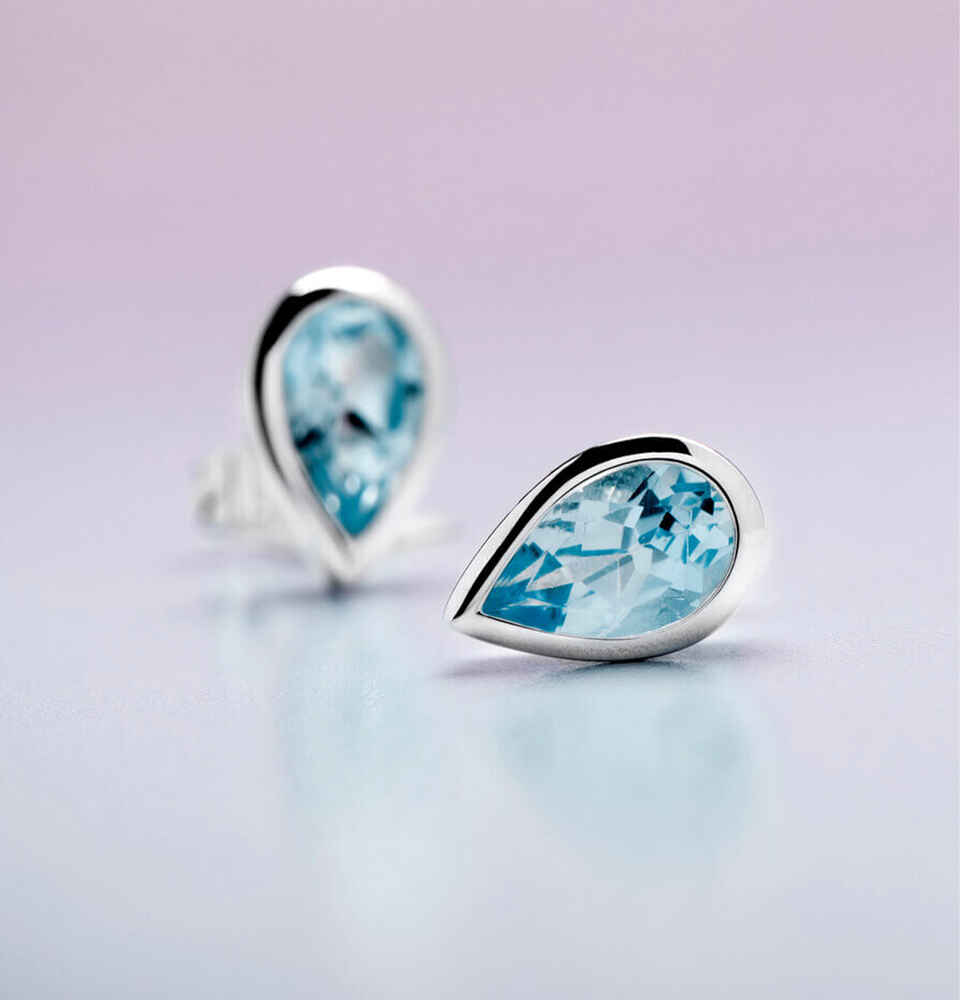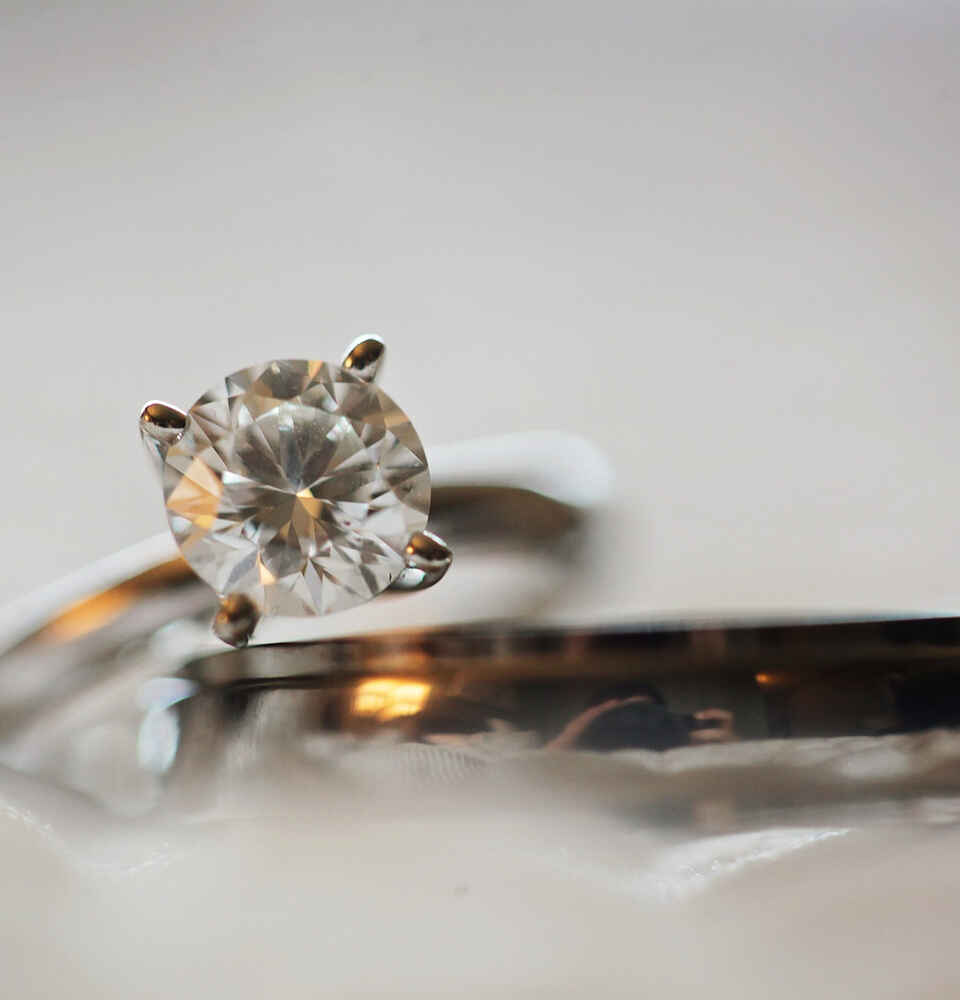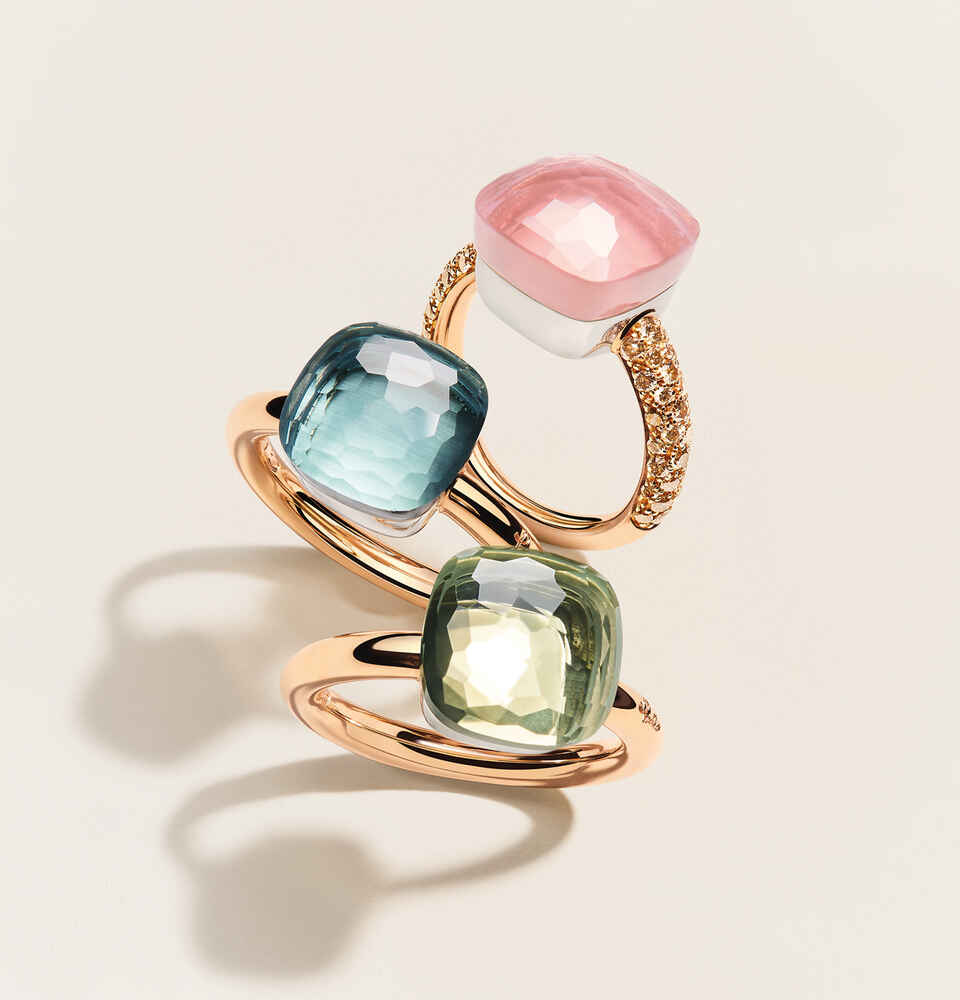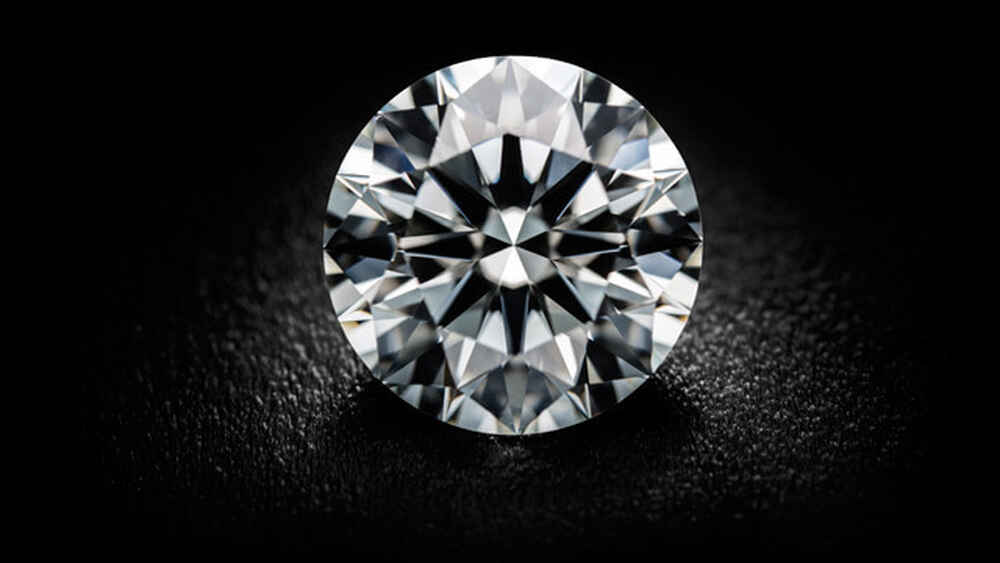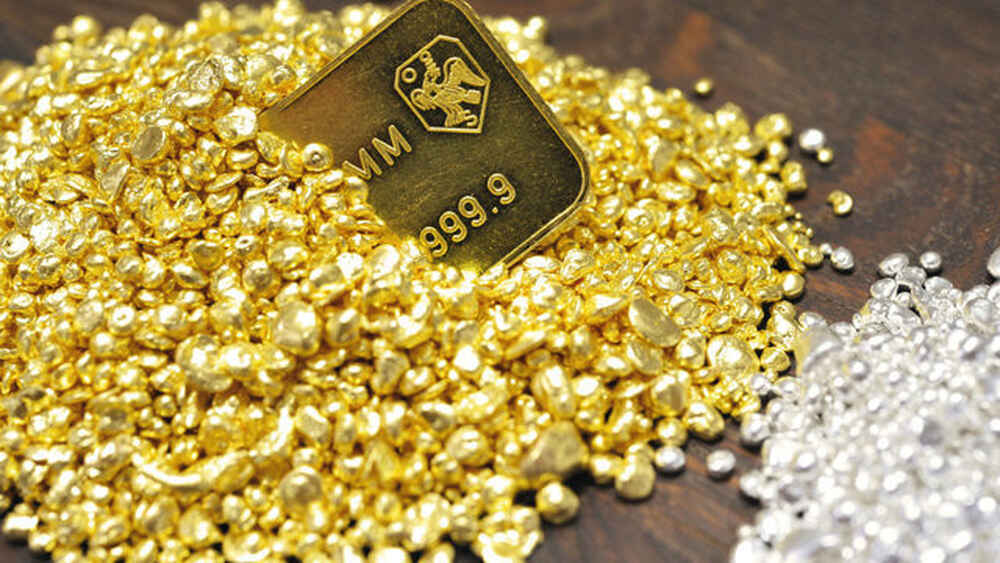An overview of the different types of grinding
Cutting diamonds has only been possible since the 20th century, as the necessary technology to process them was previously lacking. The internal light reflections are caused by the cutting of the individual facets - a process that requires the precise calculation of special angular ratios. Today, these angles are calculated and simulated on computers before the diamonds are cut on automatic machines. Since the 1980s, the stones have also been processed with lasers to remove small impurities and to mark them.
Over the years, many different types of cuts have evolved. The most widespread today is the brilliant cut. Depending on the piece of jewelry, another cut may be suitable. With the perfect cut, diamonds are a very special investment. We at BROGLE know this and that is why we offer loose diamonds for sale: Brogle Diamonds.
There are two methods of turning a stone into a gemstone: by smooth cutting or facet cutting. In the first case, the stone acquires a flat surface over which one can look into its depths. In the second case, it multiplies its light through a system of many straight surfaces that are at certain angles to each other. Diamonds are always cut in the facet cut.
The best known smooth cut is the cabochon. It has a round or oval shape, convex on the top and flat on the bottom. The only exception is the double cabochon, which curves outward on both sides. Advantages of the cabochon cut are that it can accentuate the texture and color shades of a gemstone. It is most commonly used with quartz, hawk eye, tiger eye, moonstone and opals. By the way, high-end watch movements sometimes have gemstone cabochons, which act as axle bearings here.
Known for many stunning pieces of cabochon jewelry, Tamara Comolli's colorful Mikado pendants and Bouton collection.
Brilliant and diamond, many believe, are two words for one and the same gemstone. But no: a brilliant is indeed a diamond, but not every diamond is a brilliant. This is because a brilliant only refers to a very specific cut form of a diamond. However, the brilliant cut is the best known of all cut shapes. A synonym for brilliant cut is round cut.
The cut brilliant diamond consists of a table, upper part, lower part, rondiste and tip. Depending on the size ratio of the parts to each other, the brilliance of the diamond is determined. The "perfect" ratio does not exist. The size distribution of the table, upper part (rondiste to table) and lower part (lower point to rondiste) differs from country to country, but mostly only in small percentages. It is undisputed that the diamond must be cut neither too flat nor too thick, because otherwise the light rays could not be absorbed and reflected properly.
The brilliant cut has been known since 1919. The mathematician Marcel Tolkowsky is considered its inventor, because he developed the completely symmetrical cut, which reflects the light optimally. The brilliant got its name from just this beautiful shine in all colors of the rainbow - the word has its origin in the French "brillant", which means shiny. If stones other than diamonds are cut according to this pattern, then this must be clearly marked. The indication "brilliant" is reserved for genuine diamonds....
The fact that a diamond can sparkle so uniquely is due to the facets, which can be thought of as small planes or platelets on the diamond's surface. A brilliant cut diamond has at least 32 facets in the top plus table and at least 24 in the bottom. Anyone who has ever had a diamond dance in the light will have seen that the stone also has a colored play of light on its surface. This phenomenon is called the "fire" of the diamond and is based on the physics of dispersion. Here, white light is deflected from its normal direction of incidence and thus refracted into its individual colored wavelengths of light. In a brilliant, this occurs mainly at the slope of the top towards the table. The larger this is, the more fire the diamond has. However, since the table would lose space in this case, the stone would lose brilliance, since this primarily comes from the table. A well-cut diamond therefore maintains a balanced relationship between the table and the rim of the upper part - between brilliance and fire.
Diamonds in brilliant-cut settings are popular for all types of jewelry, but they are especially in demand for engagement rings. Here, the brilliant not only crowns classic solitaire rings with a prong setting, but can also be set in a bezel setting, channel setting or pavé setting.
Not only in Greek mythology, hearts and arrows also create great emotions in diamonds. Hearts and Arrows diamonds have probably the best and most desirable diamond brilliant cut there is. If you look at the stone from below, the hearts will be visible, and from above, the arrows should be visible. However, only when eight of each of the two symbols are visible can the stone officially dub itself a Hearts and Arrows diamond. They are considered the epitome of perfect symmetry.
The oval cut helped the Russian Lazare Kaplan into the "Hall of Fame" of jewelers, who brought the already known oval diamond shape to perfection in 1957. His oval cut is based on the brilliant cut, but stretches the diamond in a 3:2 ratio of length and width. Again, perfect symmetry is of considerable importance to the luminosity of the stone. Oval brilliant diamonds have 58 facets. One advantage of the oval cut is its so-called "optimal carat weight" - the symmetrical elongated shape makes the diamond appear larger than it actually is. As the gemstone of engagement rings or other rings, ovals can also make fingers appear visually more delicate and longer. A disadvantage of the oval cut, on the other hand, is the "bow-tie effect" or "fly effect": a low-light zone forms under the upper table, the outline of which resembles a tied fly. However, this effect can be mitigated with skillful fabrication.
A penduloque cut is - as the name suggests - reminiscent of a pendulum in shape, as the gemstone is wide and rounded at the bottom and pointed at the top. Likewise, a teardrop or pear can be seen in its outline, which is why this cut shape is also known by the names teardrop cut, pear cut, pear core cut or pear shape cut. Another French name is briolette. The penduloque cut is especially popular for earrings. You can find drop-cut earrings in our online store, such as this stud earring with 38 brilliant-cut diamonds from our Royal collection. Even the inventor of the polishing wheel for diamonds, Lodewyk van Berquem from Flanders, cut stones in a teardrop shape.
The pendulum oque has proportions ranging from 15/10 to 17/10 in the ratio of the long side to the short side and usually has 58 facets. The lower main facets can be between 4 and 8; a variation with a top of star facets is also possible. Thus, diamonds and other gemstones in the Pendeloque cut can appear quite different. The bow-tie effect can also occur with the teardrop shape, meaning that shadows can form on the central facets. Optimally, the Pendeloque cut has a rounded bottom and a polished rounded ridge (the widest part of the stone). However, a less rounded shape can visually elongate the fingers.
The marquise cut has a fascinating history. In the mid-18th century, King XV of France commissioned his court jeweler to cut a diamond that would reflect the smile of his famous mistress, the Marquise Madame de Pompadour.
The Marquise brilliant cut, which is common today and tapers in two directions, has a similar shape to a boat hull and is therefore also called a "navette". Of the 58 facets, 33 are in the upper part and 25 in the lower part. Sometimes the marquise is cut with a so-called "French point". Then there is a star facet on the bottom, as well as heart and teardrop cuts.
Optimally, the proportions of the marquise shape should be 2:1. However, the shape is often more elongated or compressed. The bow-tie effect can also be seen in the marquise cut when the central facets form a shadow. Similarly, this effect occurs with teardrop, oval and heart cuts.
One advantage of the marquise cut is that it appears larger than other cuts with the same weight. Moreover, as a part of a ring, it can visually lengthen the finger. It is often combined with brilliant-cut diamonds or pendulum oque cuts. You can recognize a high-quality marquise cut by the fact that the light does not come out unbroken at the bottom and in this way the fire is not diminished.
Like the baguette cut, the emerald cut belongs to the staircase cut shapes, which means that the facets are arranged in steps. In the emerald cut, these steps lead to a wide, open table, which here appears like a pedestal. The name "emerald" cut can be confusing; although it was developed specifically for emeralds, it is now also used quite naturally for diamonds and other gemstones. Another characteristic of the emerald cut is its elongated, almost rectangular shape with cut corners. Normally, the emerald cut has 57 facets, the majority of which (32) are located on the bottom part. However, the number of facets varies according to the number of "steps". The aspect ratio is also variable, ranging from 13/10 to 15/10. A more elongated shape in finger rings has the advantage of visually lengthening the fingers.
The emerald cut is one of the most famous and oldest cuts. While it has less fire than a brilliant cut, it has its own unique appeal because of the wide table that reveals the diamond's purity. Therefore, diamonds of higher clarity are recommended for emerald cuts.
Related to the emerald cut is the baguette cut, which was developed explicitly for diamonds in 1925. Its rectangular shape is much narrower and more elongated than the emerald cut. Since there are only two rows of steps around the elongated table, it also has far fewer facets. Often, baguette cut diamonds serve as side stones of emerald cut diamonds.
Developed only in the 70s, the princess cut belongs to the modern cut shapes. Since there is a patent right for the Princess Cut, it is also sold in a similar form as Square Modified Brilliant. However, the original princess cut is square or minimally rectangular. Because it has 57 or 76 facets, as well as a pyramid shape with angled edges, it can disperse more light than any other rectangular shape. As a "square brilliant", it is popular for solitaire engagement rings as well as earrings. Because of its shape, princess cut diamonds can be set next to each other without gaps, making them wonderful for memoire rings. We recommend solitaire rings with princess cut diamonds especially for slender, longer fingers.
There are many other cuts of diamonds and other gemstones, but they are rarely used today. A very traditional cut, for example, is the rose cut or diamond cut. This was already developed in Holland at the end of the 16th century for diamonds, but today it is almost only used for garnets. The full Dutch rose has 24 facets, each in a triangular shape. However, since diamonds can be cut with a saw, the rose cut is only used for very small specimens. Often these consist of only three to six triangular facets, which are then called diamond diamonds rather than roses. Diamond diamonds are often used as setting stones: they are used for borders of larger stones or for pavé settings.
Also popular for setting stones is the octagonal cut. For smaller diamonds up to a maximum of 0.02 carats, it can even create a greater fire than a brilliant. This is a cut diamond with eight facets each in the top, bottom and table.
Our overview proves: the different diamond cuts are as numerous as the facets of a brilliant. Since they also have different qualities apart from their appearance, the choice for the right diamond jewelry or the matching solitaire ring is not always easy. We are happy to help you find your individual diamond!
